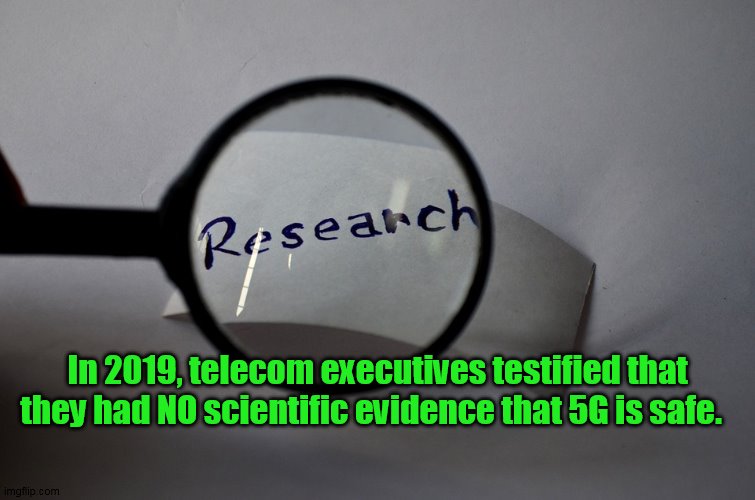 By B.N. Frank
By B.N. Frank
Opposition to 5G deployment, activation, and use is worldwide as it’s been associated with numerous significant safety issues. This has delayed, limited and/or stopped deployment in some locations but obviously not everywhere. In fact, it seems that the U.S. Department of Defense (DoD) plans to continue spending millions on it with the hope that someday it’ll be secure enough to use.
From Defense One:
Security remains a challenge as Pentagon broadens 5G plans
As DoD looks to put next-gen cell service to work against China, it will lean heavily on R&D by the US telecom industry.
5G communications could help U.S. military pilots fly better sorties and allow ground units detect and outmaneuver their adversaries—but only if U.S. telecommunications companies can find ways to keep that battlefield data safe from China, a top Pentagon communications official said.
The Defense Department is spending heavily on 5G—roughly $650 million over the past three years—but most of that is going to pilot programs to demonstrate military-specific use cases for the next-gen technology standard, according to Thomas Rondeau, the Defense Department’s principal director for FutureG. The research and development needed to make 5G secure is largely being handled by private companies.
“We estimate roughly $100 billion a year of R&D that the commercial industry puts into telecommunications. So that’s how they’re advancing,” Rondeau said at an Atlantic Council event.
That’s great news for the Pentagon: industry is taking the lead in trying to make 5G more secure. What the DOD can provide is testing and experimentation opportunities to prove out 5G technologies that could also have value in the commercial sector, such as smart warehouses.
The Pentagon is also experimenting with how 5G might fit into battlefield scenarios, such as combat-aircraft missions.
 The Naked Future: What Happens in a World That Anticipates Your Every Move?
The Naked Future: What Happens in a World That Anticipates Your Every Move?
“The F-35, that is a beast of a sensor system,” Rondeau said. “The amount of data that comes off of that thing is incredible. How do we make sense of that fast enough that by the time that that F-35 is ready to go back into its next sortie, it’s reprogrammed with the data that it needs to fight its mission?
“How do we actually [acquire] that data and move it to the people who are going to run those algorithms, make sense of it? We’ve been working with a lot of different edge compute in that high-bandwidth aspect of 5G. That’s going to help out with that.”
On the battlefield, getting the most out of 5G will require innovative approaches to the electromagnetic spectrum.
“5G introduced the idea of using millimeter wave up in the 10s of gigahertz,” Rondeau said. “Now you have this huge opportunity, again, back to that maneuver space, to take advantage of the physics… every piece of the electromagnetic spectrum at your to your advantage.”
But the challenge remains finding new ways to secure that data. That becomes especially important as the Pentagon looks toward the South China Sea.
Here, the U.S. military faces an enormous challenge: It needs to process and transfer much more data, and faster, not only between drones, sensors, satellites and troopsbut also between allied military partners, many of whom the United States can’t share all of its information with. But it also has to keep China from accessing that data.
Rondeau said the Pentagonis “working closely with our industry base to define new technologies that will help us…enhance our low probability of detection interception or anti-jam capabilities within standards-compliant 5G systems.”
Open standards
Central to DOD’s visions of future operations in the Indo-Pacific is the network concept called the Mission Partner Environment. It’s envisioned as a receiving and redistribution point for all the relevant data that could be coming in off the battlefield (in the case of the Indo-Pacific, a “field” that is thousands of kilometers in size.) Entities on the network—soldiers, operators, commanders, partner militaries—will have access only to the information that is appropriate for them. Key to getting that relevant data close to combat back to the network will be edge computing, an area where 5G could play a big role.
One former Defense Department official who spoke to Defense One said that INDOPACOM’s Mission Partner Environment will be based on lessons from CENTCOM’s experiences and fundamentally different from the way the military has traded information with allies in the past.
“According to the net-centric concept, which is how we’ve been in the past, you have a mission network specifically for an individual [bilateral connection or bilat] between the U.S. and say, Country X, and so that’s your bilat and all your information sharing is down there,” the former official said. “If you want to start a new bilat with someone else, or create a multilateral network, you have multiple countries, you have to build a brand-new network. And so obviously, scalability here becomes a serious problem. We’ve got 60 or 70 of these things out there right now across all the different [combatant commands].”
Future information trading between partners must be less about building network connections and much more about regulating the data that’s on the network, regardless of where it comes from, said the former official. That idea aligns with a security framework built on managing access to individuals regardless of the network they are on. DOD is requiring combatant commands, agencies and offices to change to thiszero trust security architecture.
“You can leverage technology that allows you, at the data object level, the same separation as you would have had in the old net-centric methodology. So you don’t have to have a new network to control access to a particular set of data. You can just utilize digital access control policies to control that access” the former official said.
Much of the recent military exercises between U.S, forces and Pacific partners has focused on precisely that issue. Eric Tapp, who runs the Mission Partner Environment program at GDIT, said that the company has been hired by the Pentagon to build a system that helps move the military from data-centric computing to MPE. Tapp said GDIT is also helping the military better understand how its going to collect data very close to or in combat transfer it to where it needs to go and also manage access to it.
“We’ve built a system of like capability, functioning along the same standards that those COCOM mission systems are operating on. And so what that gives us the opportunity to do is to test the interoperability between our edge capability and a core enterprise, to kind of an operational level capability, so we can start to model the full end-to-end enterprise,” he said.
Tapp said GDIT is working on “future proof of concept demonstrations and integration of the capability that we showed at the Talisman Sabre [exercise] in as many exercises as they’re able to integrate us.”
But the Defense Department’s plans for faster, higher-volume communications using more of the electromagnetic spectrum assume that U.S. telecommunications companies have somesay in the writing of commercial and industry standards for future 5G networks.
Rondeau said China, a huge player in commercial telecommunications with its own 5G industry, is pushing its own set of standards in international forums. Some of these have been called authoritarian, such as China’s New IP plan to compel people to register with national authorities before using the internett, which could open them up to censorship or even prosecution.
Said Rondeau: “Our ability to make sure that we’re driving the technologies forward with appropriate values embedded in them is critical. And that’s a tough question controversial statement to think that technology has values.”
Patrick Tucker is science and technology editor for Defense One. He’s also the author of The Naked Future: What Happens in a World That Anticipates Your Every Move? (Current, 2014). Previously, Tucker was deputy editor for The Futurist for nine years. Tucker has written about emerging technology in Slate, The Sun, MIT Technology Review, Wilson Quarterly, The American Legion Magazine, BBC News Magazine, Utne Reader, and elsewhere.
Activist Post reports regularly about 5G and other unsafe technologies. For more information, visit our archives and the following websites:
- Environmental Health Trust
- Americans for Responsible Technology
- Children’s Health Defense
- Electromagnetic Radiation Safety
- The National Call for Safe Technology
- Physicians for Safe Technology
Image: Pixabay
Become a Patron!
Or support us at SubscribeStar
Donate cryptocurrency HERE
Subscribe to Activist Post for truth, peace, and freedom news. Follow us on SoMee, Telegram, HIVE, Minds, MeWe, Twitter – X, Gab, and What Really Happened.
Provide, Protect and Profit from what’s coming! Get a free issue of Counter Markets today.


Be the first to comment on "Top Pentagon Official on Military Use of 5G: “the challenge remains finding new ways to secure that data”"